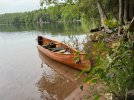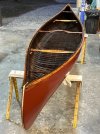Norm Hein
Canoe Codger
Glen,
I normally I take great care in all projects I do but this one got away from me.
Thanks for your response and well wishes.
Mike,
Hopefully I will be able to hone my Wood/Canvas skills whether it be building new, restoring old or repairing. I have one in the wings that I will do a few things differently on. One thing is protect the new canvas from my knife wheeling escapades. I will also use the old school filler. I just finished putting mastic filler on this one and it pretty much looks like a big white turd! A gallon or two of thick primer should help
I normally I take great care in all projects I do but this one got away from me.
Thanks for your response and well wishes.
Mike,
Hopefully I will be able to hone my Wood/Canvas skills whether it be building new, restoring old or repairing. I have one in the wings that I will do a few things differently on. One thing is protect the new canvas from my knife wheeling escapades. I will also use the old school filler. I just finished putting mastic filler on this one and it pretty much looks like a big white turd! A gallon or two of thick primer should help






